Vimy Ridge – Memorializing the Dead
by Glenn Warner
Maple Leaf Up presents the following photo essays:
Vimy Intro – Vimy Ridge April 1917
Vimy 1 – Vimy Battlefield photos April 1917
Vimy 2 – this page – Constructing the Vimy Memorial 1925-1936
Vimy 3 – Glenn Warner Photography — Vimy Pilgrimage 2007
The construction of the Vimy Memorial, 1925-1936.
The stunning Vimy Ridge Memorial, officially known as the Canadian National Vimy Memorial, lies atop Hill 145 on the escarpment overlooking the Douai Plain in the Pas-de-Calais department of France. In 1922, the Republic of France "in the name of the people of France" donated 250 acres of the escarpment in perpetuity to the people of Canada. The memorial was designed by sculptor and architect Walter Allward who claimed the idea came to him in a dream. Construction began in 1925 and took 11 years to complete.
King Edward VIII unveiled the memorial on 26 July 1936, in one of his only official duties as monarch before his abdication. He performed in front of an audience of over 100,000 people. As one newspaper said, it was as many people as had been there during the fierce fighting of 9th to 12th April 1917. More than 10,000 Canadian "pilgrims" made the journey for the dedication almost eighteen years after the Armistice of 1918. One of the pilgrims was Canada's first Silver Cross Mother, Mrs. Charlotte Woods from Winnipeg. Seven of her 12 sons served in WW1. Two were killed.
The memorial commemorates the 11,169 Canadians missing in the battles of France between 1915 to 1918 and who have no known grave. To be clear, that's eleven thousand Canadians who are memorialized on the monument because their bodies were never found, or never identified, in the battles in France alone.
*****
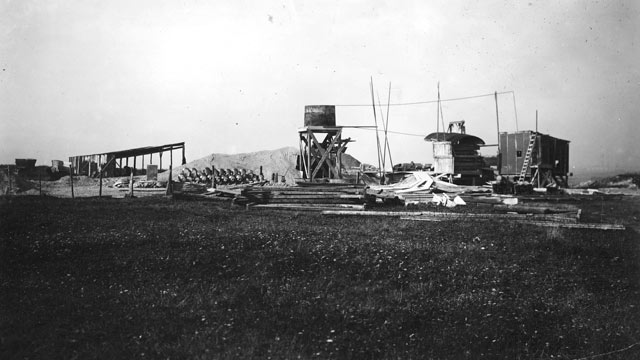
It starts with nothing but a hilltop. Add a pile of cement and what looks like a water tower to make concrete. (Library and Archives Canada)
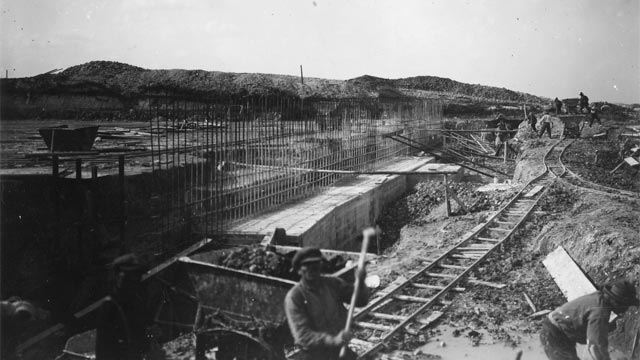
Laying the foundation in the early 1930s. Two years after the war ended in 1918, the newly formed Canadian Battlefields Memorials Commission held their first meeting in 1920 to commission eight Canadian battlefield memorials on the Western Front in Europe. (Library and Archives Canada)
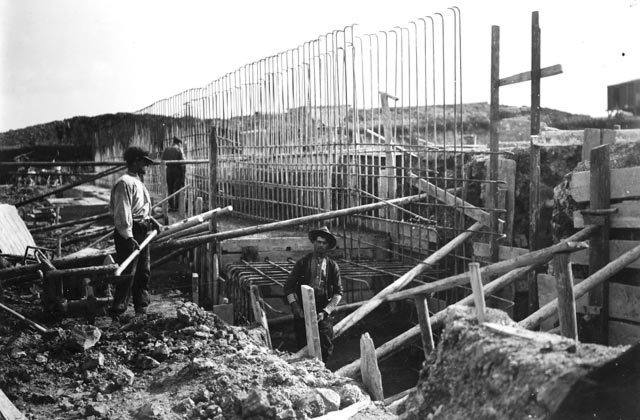
Early 1930s — the foundation of 15,000 tonnes of concrete is reinforced with hundreds of tonnes of steel according to Veterans Affairs Canada. In 1921, designer Walter Allward was granted the commission for one of the eight memorials, but the scope of his design made it unique among the other seven, and it needed a larger tract of land. In 1922, the Canadian government negotiated with France the granting of 250 acres of land, in perpetuity, centred on Hill 145 on Vimy Ridge. (Library and Archives Canada)
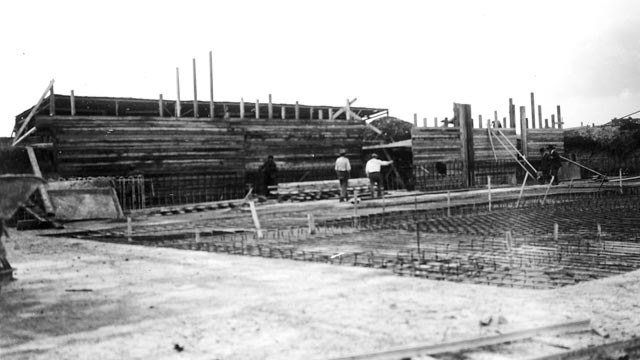
Construction of the memorial site, including all the new roadwork and landscaping, began in 1925 and would take eleven years to complete. Part of the problem was the time-consuming task of clearing the battlefields of unexploded ordnance. Many areas of the Vimy site are still inaccessible for this very reason. (Library and Archives Canada)
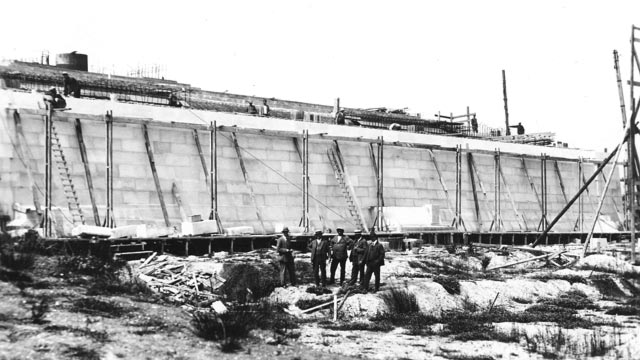
Early 1930s — the 24 foot tall front wall of the monument on the east side — the downslope towards the Douai Plain. Allward's choice of stone for memorial was a very-impractible-to-obtain-and-move limestone from an ancient Roman quarry in Seget, Croatia. Consequently, the first stones didn't arrive until 1927. (Library and Archives Canada)
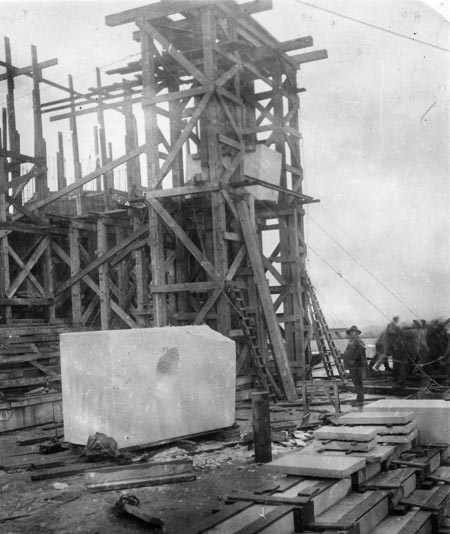
Large block of limestone from Seget, Croatia. The wood framing for construction of the twin pylons begins. (Library and Archives Canada)
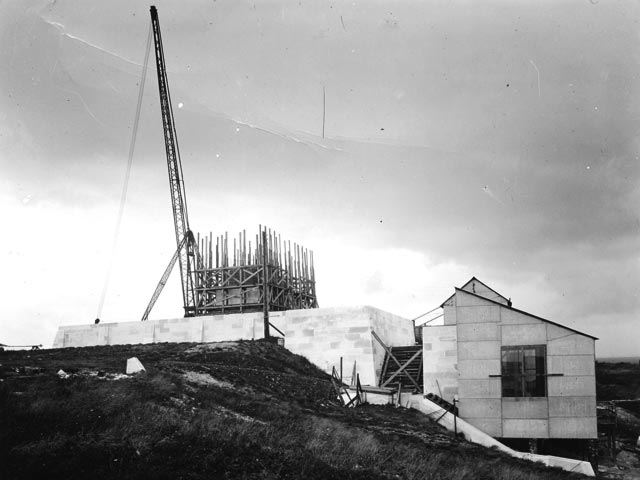
South side of the monument with the twin pylons being formed with the help of a crane. Former Canadian Corps commander Sir Arthur Currie thought a more apropos location for such a monument to Canada's Great War sacrifices should be Hill 62 in Belgium. (Library and Archives Canada)
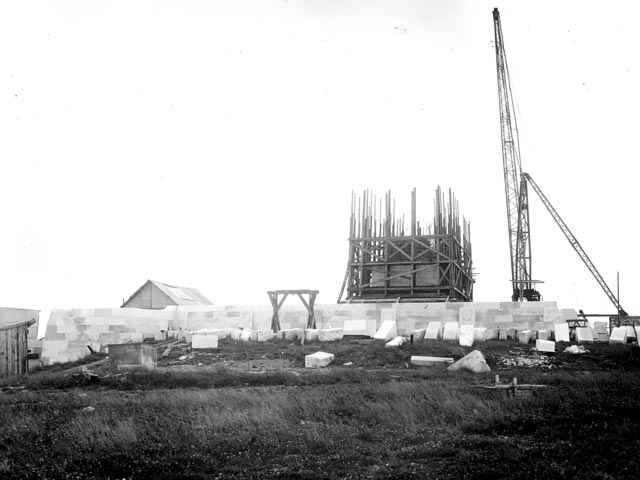
View of the north (left) side. Of the approximately 960 National Historic Sites of Canada, only TWO are located outside of Canada — both in France. One is the Canadian National Vimy Memorial, and the other is the Beaumont-Hamel Newfoundland Memorial to commemorate the Dominion of Newfoundland forces members who were killed in The Great War. Parks Canada assumed administration of Beaumont-Hamel in 1949 when Newfoundland joined the Canadian confederation. (Library and Archives Canada)
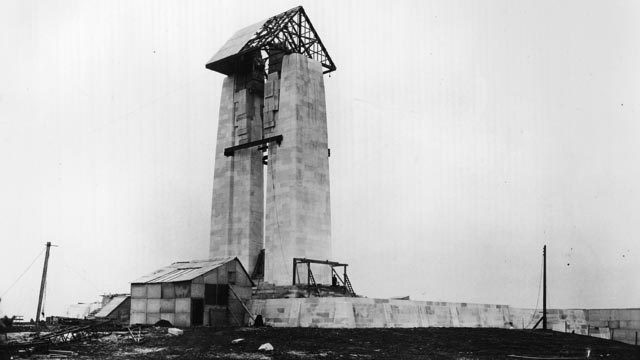
A view from the rear. The centre pylons are up, and a protective structure is being constructed on the top so the sculpting can begin. Allward claimed the design came to him in a dream with the two pylons representing Canada and France — two nations beset by war and united in their fight for peace; and freedom for the Allied nations. (Library and Archives Canada)
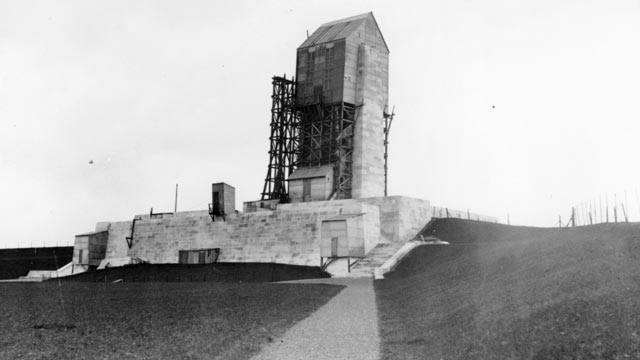
A view from the front. The temporary protective structure has been constructed on top of the centre pylons for the carving of the top statues. There are two smaller protective boxes front and centre where the "Canada Bereft" (Mother Canada mourning her dead) statue and Sarcophagus are being carved, or will be carved. The base and twin pylons contain almost 6,000 tonnes of the extremely durable Seget limestone, which Allward discovered, during his search for a good building stone, at Roman Emperor Diocletian's Palace in Split, Croatia. Some of the larger sections of Seget limestone did not arrive in Vimy until 1931. (Library and Archives Canada)
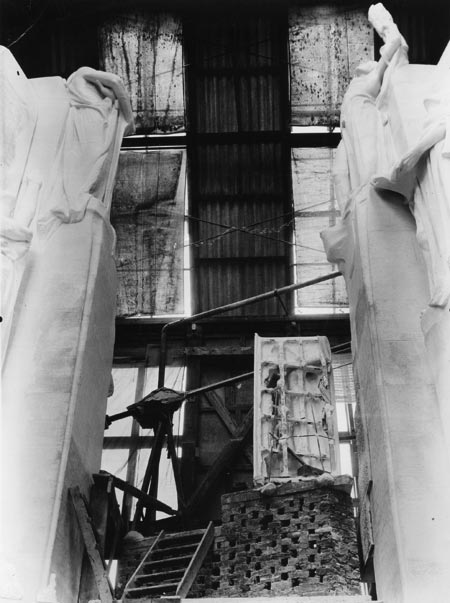
Now inside the temporary protective structure atop the pylons. The carvings were done in place on the monument in the early 1930s after the larger limestone blocks arrived. At the top of the 27 meter high pylons is a group of figures collectively called "The Chorus". In this photo, on the right, atop the north pylon, is the female figure "Peace" with "Honour" just below. Atop the south pylon is "Justice". The smaller white box in the centre of the photo looks like the back of a plaster maquette for one of the sculptures. (Library and Archives Canada)
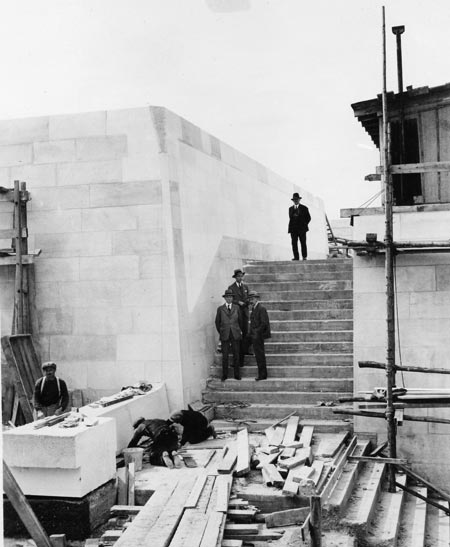
The left front entrance steps of the memorial showing a blank panel where names of the Canadian missing will soon be carved. (Library and Archives Canada)
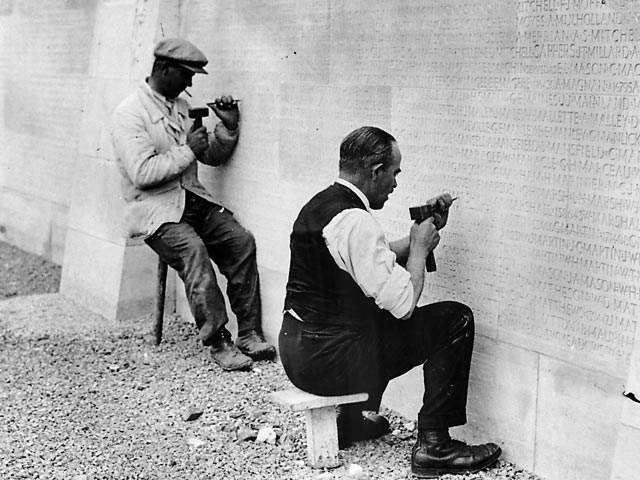
Carving of the names of the 11,000+ Canadian Missing in France on the memorial walls. The idea of the names was not included in Allward's original commission and he protested as to their addition. The Canadian Battlefields Memorials Commission's rebuke forced Allward to change his attitude and the inscriptions began in the early 1930s, using a typeface that Allward himself designed specifically for the memorial. (Library and Archives Canada)
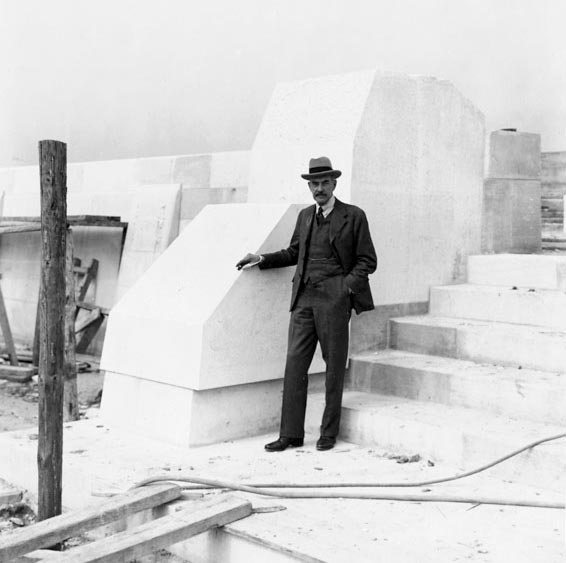
Architect and designer Walter Allward stands next to the blocks ready to be carved into the reclining female mourner on the reverse side of the monument. Commissioned in 1921, the monument would consume fifteen years of Allward's life until the dedication and unveiling in 1936. (Library and Archives Canada)

Now under a temporary protective cover, the sculpting of the reclining female mourner is near completion. The plaster maquette to the upper right of the photo now resides in at the Canadian War Museum in Ottawa in the sublime Regeneration Hall. This photo may have been taken by Allward himself on 18 October 1932. He made a note: "Showing one of the reclining figures at rear of Memorial. Only a few touches on masonry and it will be finished. Impossible to get any other view of this figure at present. Walter Allward." (Library and Archives Canada)
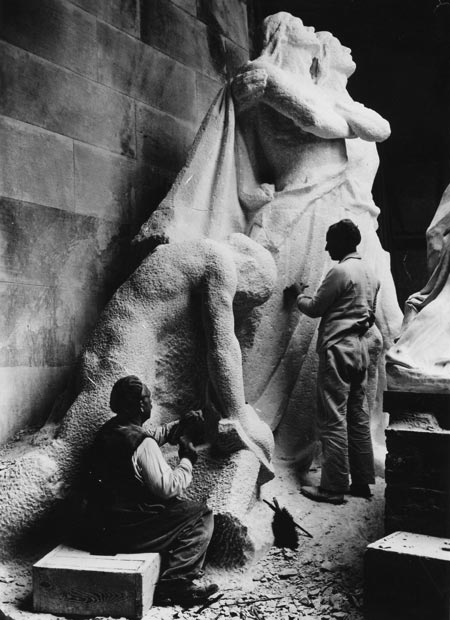
"Breaking of the Sword" represents the defeat of war and militarism. The monument is adorned with the sculptures of 20 figures. (Library and Archives Canada)

Carving the stone sarcophagus which lays at the centre base of the monument below the statue of "Canada Bereft" (Mother Canada mourning her dead). (Library and Archives Canada)
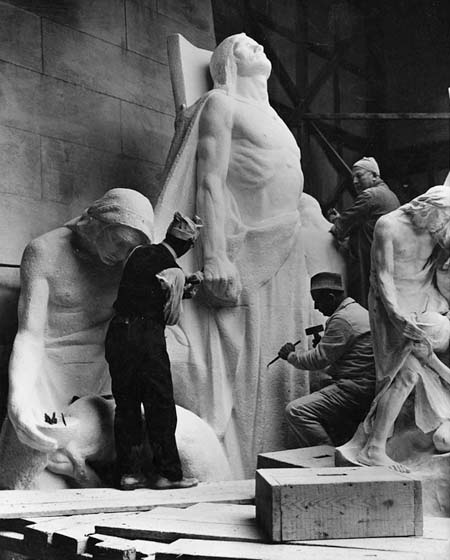
Under protective cover, the sculptors are on scaffolding carving the middle of the statue "Sympathy of the Canadians for the Helpless". Plaster maquette in foreground. (Library and Archives Canada)

The finished statue "Sympathy of the Canadians for the Helpless" in which the standing "Canadian" figure elicits sympathy for the weak and oppressed. (Library and Archives Canada)
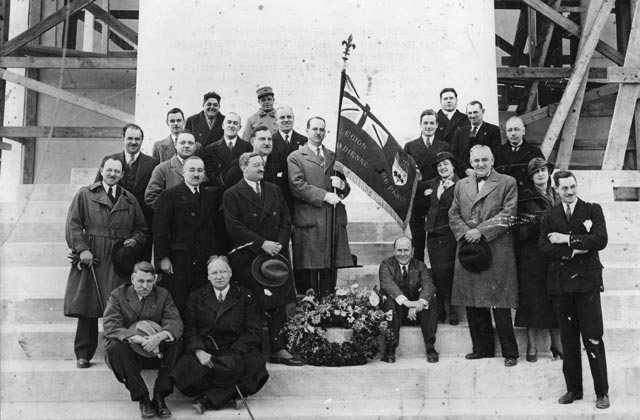
A wreath-laying visit during construction of the Vimy Memorial. The ensign with the fleur-de-lis flagpole seems to say Legion Canadienne de Paris. Let us know if you have information. Do you recognize anyone? (Library and Archives Canada)
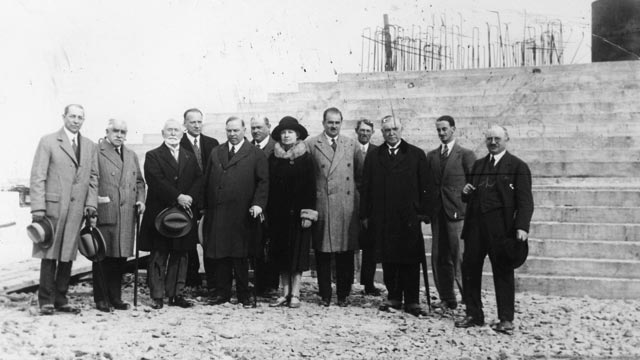
Another visit by an official party includes Canadian Prime Minister Mackenzie King, (fifth from the left) and Ernest Lapointe (far right) — the PM's Quebec Lieutenant and Minister of Justice in cabinet. The Liberals were returned to power in October 1935 so this visit to the construction site is obviously after that — perhaps spring 1936. Let us know if you recognize the other members of the party. (Photographer: possibly Paul Horsdal of Ottawa; Library and Archives Canada)

Aerial view of the monument, completed. (Library and Archives Canada)
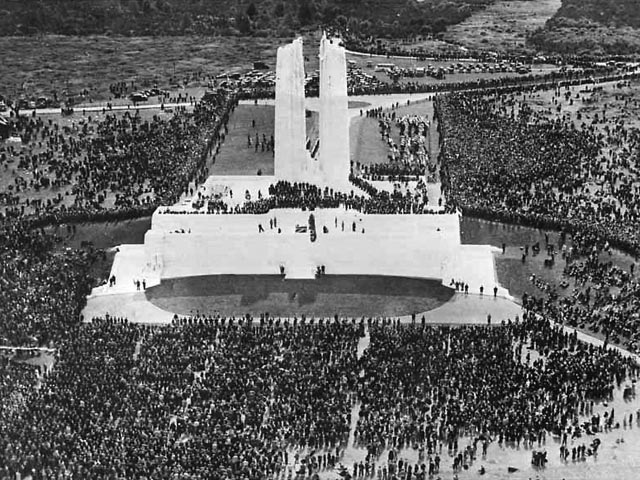
Dedication and unveiling of the Canadian National Vimy Memorial on 26 July 1936. Over 100,000 people were in attendance, as one newspaper said, as many people as had been there on 9 April 1917. The total included 8,000 Canadian veterans (6,000 of whom made the pilgrimage on steamships from Canada). Including the British and French vets, over 50,000 Great War veterans were in attendance altogether. King Edward VIII, who was monarch of the Commonwealth realms at the time, performed the dedication by unveiling the statue of "Canada Bereft" (Mother Canada mourning her dead). It has been said to have been Edward's only official duty as monarch given his short reign that began in early January 1936 and ended in December. (Library and Archives Canada)

After unveiling the statue of "Canada Bereft" (Mother Canada mourning her dead), Edward VIII (centre) descends the stairs of the monument to greet some of the attending Canadian pilgrims. L to R from bottom to top: Brig-Gen. Alex Ross, President of the Canadian Legion; Major-General S.H. Burstall, wartime commander of 2nd Canadian Division; His Majesty Edward VIII. Top row L-R: Hon. Ernest Lapointe; Maj-Gen. Sir Archibald Macdonald, wartime commander of 1st Canadian Division; Hon. Ian Mackenzie, Minister of National Defense. (Library and Archives Canada a183542)
*****
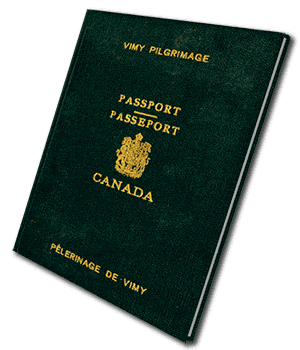 Incredibly, Canadians were British subjects until 1947, so in 1936 the British passport was still being issued to the few Canadians who travelled to Europe at the time. (Travel to the U.S. did not require a passport.) So the Canadian government issued special no-cost Canadian Pilgrimage passports just for the Vimy Dedication event.
Incredibly, Canadians were British subjects until 1947, so in 1936 the British passport was still being issued to the few Canadians who travelled to Europe at the time. (Travel to the U.S. did not require a passport.) So the Canadian government issued special no-cost Canadian Pilgrimage passports just for the Vimy Dedication event.
The idea for having Canadian memorial monuments was in the sights of the federal government two years after the end of the Great War in 1920. Though it wasn't the only monument, Vimy was by far the largest and took fifteen years to complete before its debut in 1936. In three years time, Canada would again be at war against its former enemy.
The Canadian National Vimy Memorial site is managed by Veterans Affairs Canada. The beautiful maquettes for the sculptures can be seen in the Canadian War Museum in Ottawa.
The photostory of Vimy Ridge continues next page. ![]()
*****
If you have any observations, comments, insights, or see any errata, typos, or anything nutty when viewing these photos, please contact us. (Refer to photo reference numbers if possible.)





